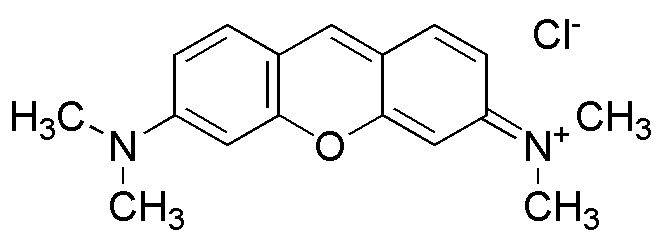Pyronin Y is widely utilized in research focused on:
- Fluorescent Staining: Commonly used in biological research for staining RNA in cells, allowing researchers to visualize cellular components under a fluorescence microscope.
- Histology: Employed in tissue sectioning to highlight nucleic acids, aiding pathologists in diagnosing diseases by providing clear contrasts in tissue samples.
- Flow Cytometry: Acts as a fluorescent marker in flow cytometry applications, helping in the analysis of cell populations based on their RNA content.
- Environmental Monitoring: Utilized in studies to detect and quantify RNA in environmental samples, contributing to ecological research and monitoring of microbial communities.
- Drug Development: Assists in the development of RNA-targeted therapies by providing insights into RNA dynamics and interactions, crucial for pharmaceutical research.
Información general
Propiedades
Seguridad y normativas
Aplicaciones
Pyronin Y is widely utilized in research focused on:
- Fluorescent Staining: Commonly used in biological research for staining RNA in cells, allowing researchers to visualize cellular components under a fluorescence microscope.
- Histology: Employed in tissue sectioning to highlight nucleic acids, aiding pathologists in diagnosing diseases by providing clear contrasts in tissue samples.
- Flow Cytometry: Acts as a fluorescent marker in flow cytometry applications, helping in the analysis of cell populations based on their RNA content.
- Environmental Monitoring: Utilized in studies to detect and quantify RNA in environmental samples, contributing to ecological research and monitoring of microbial communities.
- Drug Development: Assists in the development of RNA-targeted therapies by providing insights into RNA dynamics and interactions, crucial for pharmaceutical research.
Documentos
Hojas de datos de seguridad (HDS)
La SDS proporciona información de seguridad completa sobre la manipulación, el almacenamiento y la eliminación del producto.
Especificación del producto (PS)
La PS proporciona un desglose completo de las propiedades del producto, incluida la composición química, el estado físico, la pureza y los requisitos de almacenamiento. También detalla los rangos de calidad aceptables y las aplicaciones previstas del producto.
Certificados de análisis (COA)
Busque certificados de análisis (COA) ingresando el número de lote del producto. Los números de lote y de partida se pueden encontrar en la etiqueta de un producto después de las palabras "Lote" o "Lote".
Número de catálogo
Número de lote/lote
Certificados de origen (COO)
Este certificado de origen confirma el país en el que se fabricó el producto y también detalla los materiales y componentes utilizados en él y si se deriva de fuentes naturales, sintéticas u otras fuentes específicas. Este certificado puede ser necesario para cumplir con las normativas aduaneras, comerciales y regulatorias.
Número de catálogo
Número de lote/lote
Hojas de datos de seguridad (HDS)
La SDS proporciona información de seguridad completa sobre la manipulación, el almacenamiento y la eliminación del producto.
DownloadEspecificación del producto (PS)
La PS proporciona un desglose completo de las propiedades del producto, incluida la composición química, el estado físico, la pureza y los requisitos de almacenamiento. También detalla los rangos de calidad aceptables y las aplicaciones previstas del producto.
DownloadCertificados de análisis (COA)
Busque certificados de análisis (COA) ingresando el número de lote del producto. Los números de lote y de partida se pueden encontrar en la etiqueta de un producto después de las palabras "Lote" o "Lote".
Número de catálogo
Número de lote/lote
Certificados de origen (COO)
Este certificado de origen confirma el país en el que se fabricó el producto y también detalla los materiales y componentes utilizados en él y si se deriva de fuentes naturales, sintéticas u otras fuentes específicas. Este certificado puede ser necesario para cumplir con las normativas aduaneras, comerciales y regulatorias.

